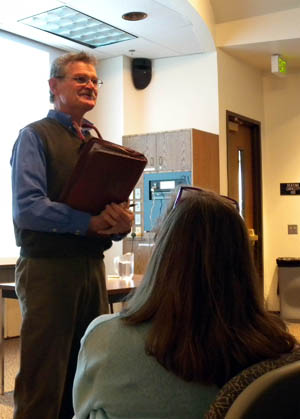Ogmius 10TH |
||
Director Bill Travis
PHOTO FROM THE PASTBill Travis introducing guest speaker Mike Hulme, November 4, 2010 |
PHOTO FROM THE PASTCSTPR faculty particiating in panel discusion about geoengineering, March 29, 2010 As a social science unit in a natural science institute, the Policy Center represents a continuing effort to illuminate that society box in the old earth system diagrams, an effort now heading into its second decade. In the last decade, and indeed in the four decades since the first earth system diagrams were created, a growing body of work on human behavior, decision-making, policy choices, and environmental impacts has enriched our understanding of both the earth and people, yielding new insights into social-ecological systems. As reflected in this 10th anniversary issue of Ogmius, our growing community of current and past faculty and students has contributed to the effort in a myriad of ways, especially focused on the choices that people make in treating the environment and in responding to challenges like natural hazards, climate change, and variability in earth sub-systems such as the carbon and hydrologic cycles. The complexity hidden in the “society” box of those early earth system diagrams has been partially clarified, and in just the decade that the Center has existed, the questions put to social scientists increasingly attend not only to how humans behave in the environment, but how humans should manage earth systems, that is, what should be our policy for the earth system. Differences between what we do, and what we should do, to perturb earth systems, and perhaps to achieve sustainability—the diagnostic, prognostic and prescriptive elements of research----will continue to pose questions for the future researchers at the Center. Bill Travis, Director |
|


 What does it mean to be a social science research center in an environmental science institute? Not, to box us in, but a box is one way to explore the roots of the social-ecological sciences. Formulations of earth systems science are often encapsulated in so-called “wiring diagrams” of interacting variables meant to sum up whole systems. In early formulations a box resided somewhere in this wiring diagram that was labeled something like “society” or “humans”. Like the other “subsystems” in the diagram, this one encompassed much more complexity than its modest size and appearance in the diagram signaled. Even as other system boxes were filled in with detail, the social box often sat blank, not because social scientists knew so little about human behavior, but because so few social scientists were yet engaged in the enterprise of explaining how earth systems functioned, and this was partly because few social scientists saw humans as part of the earth system. Still, the mostly-blank box beckoned, and some social scientists joined in the effort with theories and evidence for how humans behaved in the environment, how they changed earth systems, and how they responded to those changes.
What does it mean to be a social science research center in an environmental science institute? Not, to box us in, but a box is one way to explore the roots of the social-ecological sciences. Formulations of earth systems science are often encapsulated in so-called “wiring diagrams” of interacting variables meant to sum up whole systems. In early formulations a box resided somewhere in this wiring diagram that was labeled something like “society” or “humans”. Like the other “subsystems” in the diagram, this one encompassed much more complexity than its modest size and appearance in the diagram signaled. Even as other system boxes were filled in with detail, the social box often sat blank, not because social scientists knew so little about human behavior, but because so few social scientists were yet engaged in the enterprise of explaining how earth systems functioned, and this was partly because few social scientists saw humans as part of the earth system. Still, the mostly-blank box beckoned, and some social scientists joined in the effort with theories and evidence for how humans behaved in the environment, how they changed earth systems, and how they responded to those changes. 
